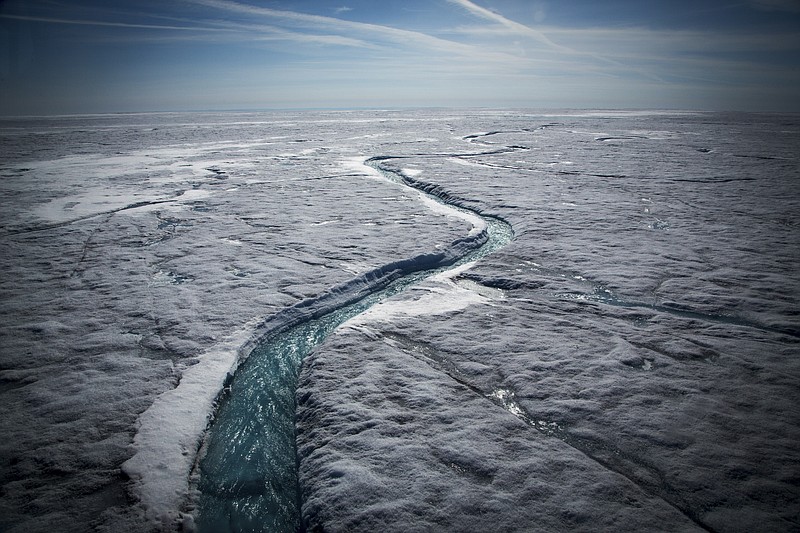Antarctic glaciers are losing six times as much ice as they were just four decades ago, thanks to our warming oceans, according to a startling new research study.
Warming oceans? Yes, 2018 was the hottest year on record for global ocean temperatures. Researchers have discovered that 90 percent of the warming caused by human-generated greenhouse gas in our atmosphere is absorbed into the world's oceans. And yes, all that warming and melting means sea levels will rise more quickly than predicted in coming decades.
The Antarctic lost 40 billion tons of melting ice to the ocean each year from 1979 to 1989. But that figure rose to 252 billion tons of ice lost per year beginning in 2009, according to a study published Monday in the Proceedings of the National Academy of Sciences.
"I don't want to be alarmist," lead researcher Eric Rignot told The Washington Post. But what he's seeing is cause for alarm.
"The places undergoing changes in Antarctica are not limited to just a couple places," said Rignot, an Earth-systems scientist for the University of California at Irvine and NASA. "They seem to be more extensive than what we thought. That, to me, seems to be reason for concern."
The study's findings are but one more sign that we face dire consequences if we allow climate change to continue unabated. Scientists already have predicted that seas could rise nearly three feet globally by 2100 if the world does not sharply decrease its carbon output. Researchers also had already warned that ice retreats in the Antarctic could push that even higher. Now the speed of Antarctica's glacier melt, occurring faster than snowfall can make up, makes this a sure bet. Global sea levels have already risen seven to eight inches since 1900.
But there's another new warning.
Not only will we see more-frequent droughts, heat waves, severe storms and other extreme weather - again, a result of warming oceans - the rising water will inundate land, wreck local economies, destroy wildlife habitats, and shrink drinking-water supplies.
There is hope.
Another new study, published this month in the journal Nature Communications, posits that climate change could be kept in check if a phaseout of all fossil fuel infrastructure were to begin immediately, according to The Guardian.
The study found that if all fossil fuel infrastructure - power plants, factories, vehicles, ships and planes - from now on are replaced at the end of their useful lives by zero-carbon alternatives, there is a 64 percent chance we can lower our risk of catastrophe. If we don't start the phase-out until 2030, the study found, our chances sink to 33 percent.
Christopher Smith, the University of Leeds researcher who led the study, told The Guardian: "We are basically saying we can't build anything now that emits fossil fuels."
If you're looking for silver linings, we have two more heartening news items - both local.
We learned last week that Volkswagen will begin assembling electric vehicles here in Chattanooga in 2022.
Transportation contributes the lion's share of greenhouse gas emissions - 28 percent - that are overheating our planet.
And, yes, producing electricity is another 28 percent whopper - especially electricity made from coal or gas.
That leads to the second bright spot in local news.
Two solar energy companies plan to put up 1.6 million solar panels at sites in Alabama and Tennessee to supply renewable energy through the Tennessee Valley Authority to power the new Google data centers being built in Hollywood, Alabama, and Clarksville, Tennessee.
Those new solar plants will be the largest in Alabama and Tennessee - and the largest solar farms ever to be built for Google. One solar farm will be built in Jackson County, Alabama, near TVA's abandoned Bellefonte Nuclear plant and soon-to-be phased out Widows Creek coal plant. The other solar farm will be near Clarksville and the Tennessee-Kentucky line. Combined, the two facilities will generate 413 megawatts of electricity from the sun. For context, that's about a third of the power that one 1,260-megawatt reactor at Bellefonte Nuclear Plant would have produced, and about a fourth of the 1,600 megawatts once produced by the eight coal burning units at Widow's Creek.
To TVA's credit, it has retired 33 of the 59 coal units it once operated in its seven-state region.
In 2015, when the Google data processing plans were announced, TVA said it was reviewing the future of the land and physical structures associated with the retired coal-fired plant units.
And just last year, TVA canceled its sale of Bellefonte and the adjoining 1,300 acres to Franklin Haney after the developer kept delaying payments and had not gained approval from the U.S. Nuclear Regulatory Commission to take control of TVA's construction permits to complete the nuclear plant.
TVA already owns all that land - perfect land for an enormous solar farm. And, yes, harnessing the sun requires workers, just like harnessing coal and atoms.
Beating climate change is a test of will, not ability. We have the ability. We must muster the will.
